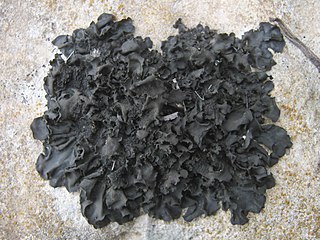
Cladonia rangiferina, also known as reindeer cup lichen, reindeer lichen or grey reindeer lichen, is a light-colored fruticose, cup lichen species in the family Cladoniaceae. It grows in both hot and cold climates in well-drained, open environments. Found primarily in areas of alpine tundra, it is extremely cold-hardy.

Mount Revelstoke National Park is a national park located adjacent to the city of Revelstoke, British Columbia, Canada. The park is relatively small for a national park, covering 260 km2 (100 sq mi). It is located in the Selkirk Mountains and was founded in 1914. Approximately 600,000 visitors enter Mount Revelstoke and nearby Glacier National Park each year.

Bryoria fremontii is a dark brown, horsehair lichen that grows hanging from trees in western North America, and northern Europe and Asia. It grows abundantly in some areas, and is an important traditional food for a few First Nations in North America.

Collema is a genus of lichens in the family Collemataceae. The photobiont is the cyanobacterium genus Nostoc.

Absconditella is a genus of lichenised fungi in the family Stictidaceae. The genus was circumscribed in 1965 by Czech lichenologist Antonín Vězda, with Absconditella sphagnorum assigned as the type species. Absconditella is characterised by gyalectoid apothecia with a hymenium that is not amyloid, without a dark pigment and thalli containing green algae as photobionts. The genus name means "hidden", a reference to the scant structure of the thallus and its small apothecia.

Ramalina menziesii, the lace lichen or fishnet, is a pale yellowish-green to grayish-green foliose lichen. It grows up to a meter long, hanging from bark and twigs in a distinctive net-like or lace-like pattern that is unlike any other lichen in North America. It becomes a deeper green when wet. Apothecia are lecanorine. it is an important food source for deer in the Coast Range of California, and a source of nest material for birds. It is highly variable in its growth form, with branches sometimes so slender as to appear like strands, sometimes tiny, and sometimes large with broadly flattened branches.
Absconditella amabilis is a species of lichen in the family Stictidaceae, first found in inland rainforests of British Columbia.
Bacidina contecta is a species of lichen in the family Ramalinaceae, first found in inland rainforests of British Columbia.
Biatora aureolepra is a species of lichen in the family Ramalinaceae, first found in inland rainforests of British Columbia.
Biatora ligni-mollis is a species of lichen in the family Ramalinaceae, first found in inland rainforests of British Columbia.
Collema coniophilum is a species of lichen in the family Collemataceae, first found in inland rainforests of British Columbia.
Pertusaria diluta is a species of crustose lichen in the family Pertusariaceae, first found in inland rainforests of British Columbia.
Schaereria brunnea is a species of lichen in the family Schaereriaceae, first found in inland rainforests of British Columbia.

Haematomma ochroleucum, also known as yellow bloodstain lichen, is a species of crustose lichenized fungus. First described in 1771 by Noël Martin Joseph de Necker, it has no subspecies, but two named varieties: H. o. var. ochroleucum and H. o. var. porphyrium.

The North American inland temperate rainforest is a 7 million hectare disjunct temperate rainforest spreading over parts of British Columbia in Canada as well as Washington, Idaho and Montana on the US side. Its patches are located on the windward slopes of the Rocky Mountains and the Columbia Mountains, extending roughly over 1000km from 54° North to 45° North. It is one of the largest inland temperate and boreal rainforests in the world.
Boreal woodland caribou(Rangifer tarandus caribou) are a species of caribou and subspecies of North American reindeer. Boreal woodland caribou are also known as southern mountain caribou, woodland caribou, and forest-dwelling caribou. Mountain caribou are uniquely adapted to live in old-growth forests. The mountain caribou diet consists of tree-dwelling lichens predominantly. They are unique in this aspect as in the far northern regions of their habitat zones, the snowpack is shallow enough that the boreal woodland caribou can paw through the snow to eat the ground-dwelling lichens. In the inland Pacific Northwest Rainforests of eastern British Columbia, where the snowpack can reach upwards of five meters, the mountain caribou rely predominantly on the tree-dwelling lichens such as Bryoria spp. and Alectoria spp., hanging above the snowpack. As a result, these mountain caribou are reliant upon the old growth forests, which have been logged for centuries and continue to dwindle.

Schaereria is a genus of lichen-forming fungi. It is the sole genus in the family Schaereriaceae, which itself is the only family in the Schaereriales, an order in the subclass Ostropomycetidae of the class Lecanoromycetes.
Bacidina circumpulla is a species of crustose lichen in the family Ramalinaceae. Found in Alaska and British Columbia, it was described as a new species in 2020 by Stefan Ekman.
Parmelia imbricaria is a species of foliose lichen in the family Parmeliaceae. Found in western Canada, it was formally described as a new species in 2017 by Trevor Goward, Pradeep Kumar Divakar, María del Carmen Molina, and Ana Crespo. The type specimen was collected by Goward near the Clearwater River drainage, where it was found at an altitude of 700 m (2,300 ft) growing on a basalt boulder. The specific epithet refers to the "imbricate" lobes of the thallus. The lichen occurs in western Canada, with a range including southern Yukon and extending south to southern inland British Columbia. The European Parmelia pinatifida is a closely related species.
Hypogymnia wilfiana is a species of foliose lichen in the family Parmeliaceae. It is found in western North America, where it grows on conifer trees.








